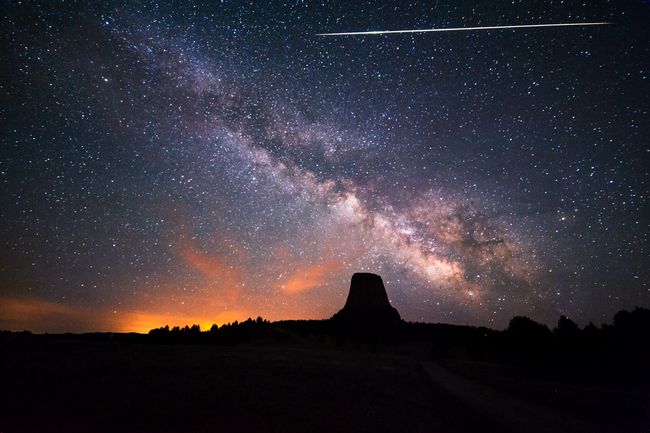Welcome to DU!
The truly grassroots left-of-center political community where regular people, not algorithms, drive the discussions and set the standards.
Join the community:
Create a free account
Support DU (and get rid of ads!):
Become a Star Member
Latest Breaking News
General Discussion
The DU Lounge
All Forums
Issue Forums
Culture Forums
Alliance Forums
Region Forums
Support Forums
Help & Search
Science
Related: About this forumThe 2020 Eta Aquarid meteor shower peaks this week. Here's how to see it.
By Joe Rao 5 hours ago
The Eta Aquarid meteor shower peaks before dawn on May 5.

An Eta Aquarid fireball lights up the sky over Devils Tower, part of the Bear Lodge Mountains in Wyoming. Astrophotographer David Kingham captured this shot during the 2013 Eta Aquarid meteor shower. (Image credit: David Kingham/Flickr/CC BY-NC-ND 2.0)
If you were born any time after 1983, there's probably a better than 50-50 chance that you'll be around in the summer of 2061 when Halley's Comet makes its 31st (observed) return through the inner solar system. Those who are older may have seen this famous comet on its last appearance during the winter of 1986. But whether you're here to greet the comet on its next return 41 years from now, you'll have a chance to spy some bits and pieces from Halley during these next few days.
Like other comets, Halley is a cosmic litterbug; about every 76 years as it sweeps closest to the sun, it leaves a "river of rubble" in its wake along its orbit. When the Earth interacts with that rubble river, those comet bits race through our atmosphere at high speeds to produce the effect of "shooting stars."
At two places the comet's orbit passes very close to our own orbit. The material that it releases into space on its way in toward the sun produce the October meteor shower known as the Orionids, while the material that is released after the comet has rounded the sun and is heading back to the outer limits of the solar system produce a meteor display in early May: The Eta Aquarids, which are due this week.
First sighted in 1870
Unlike some of the other annual meteor displays whose history can be traced back for hundreds or thousands of years, the Eta Aquarids were not "officially" discovered until the late 19th century. In 1870, while sailing in the Mediterranean Sea, Lieutenant Colonel G.L. Tupman sighted 15 meteors on the morning of April 30, and another 13 a few mornings later. All the meteors appeared to emanate from the constellation of Aquarius.
More:
https://www.space.com/eta-aquarid-meteor-shower-2020-peaking.html
InfoView thread info, including edit history
TrashPut this thread in your Trash Can (My DU » Trash Can)
BookmarkAdd this thread to your Bookmarks (My DU » Bookmarks)
3 replies, 718 views
ShareGet links to this post and/or share on social media
AlertAlert this post for a rule violation
PowersThere are no powers you can use on this post
EditCannot edit other people's posts
ReplyReply to this post
EditCannot edit other people's posts
Rec (10)
ReplyReply to this post
3 replies
 = new reply since forum marked as read
Highlight:
NoneDon't highlight anything
5 newestHighlight 5 most recent replies
= new reply since forum marked as read
Highlight:
NoneDon't highlight anything
5 newestHighlight 5 most recent replies
The 2020 Eta Aquarid meteor shower peaks this week. Here's how to see it. (Original Post)
Judi Lynn
May 2020
OP
Delmette2.0
(4,174 posts)1. What direction we watch? That would be helpful.
lostinhere
(78 posts)2. Here is where Space.com says to look.
Here is a paragraph from the Space.com article linked in the original post. It sucks that I live in central Indiana. ![]()
Because these meteors appear to radiate from a position low on the eastern horizon for mid-northern latitudes, watchers in the tropics are best placed. South of the equator this is one of the best meteor showers of the year, producing up to 60 per hour. Under the most favorable conditions from the southern United States, a dozen or more meteors per hour can be seen from the Eta Aquarid swarm. But observers from mid-northern latitudes may only see about half as many.
Delmette2.0
(4,174 posts)3. Thank you.
I don't know how I missed that. I must have been half asleep.
![]()